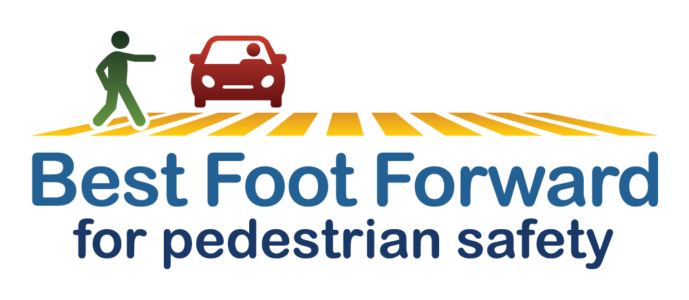Hosted by Bike/Walk Central Florida, the Best Foot Forward (BFF) Summit of 2024 continued its…

What Does Walking and Biking Have to do With the I-4 Ultimate?
So what could I-4 – an interstate highway designed to move cars from one place to another as fast as possible – have to do with biking and walking? A lot actually.
Especially near on and off-ramps where people bike or walk quite regularly. Our Best Foot Forward for pedestrian safety initiative has monitored such crosswalks (see pg. 58 and 60 of our most recent progress report).
The I-4 Ultimate project – you know the six and half year road construction project everyone’s talking about – also has plans in store for bicyclists and pedestrians.
The Orlando Sentinel and WFTV Orlando’s Jamie Holmes both report new walking paths and bike lanes are slated to be built. BWCF’s very own Amanda Day told the Sentinel that it’s a pretty big deal to see a highway project like this thinking about people who bike and walk . Here’s an excerpt from her interview with the Sentinel:
The attitude change in having road plans include walkers and bikers has been “monumental in such a short amount of time,” said Amanda Day, executive director of Bike/Walk Central Florida, which advocates for more pedestrian infrastructure. “That’s attributed a lot to SunRail and just our growth around here and rethinking growth. And it’s attributed to a lot of millennials wanting to move downtown.”
All in all, 15 miles of new sidewalks, paths and bike lanes are in the works. A few of the proposed bike/ped projects include:
- pedestrian tunnel under SR-436 in Altamonte Springs
- pedestrian bridges in Maitland (pictured below) and Downtown Orlando near Anderson Street (both will cross I-4)
- bike lanes in Downtown Orlando on Robinson and Livingston Streets, Hughey and Garland Avenues, and Colonial Drive
I-4 Ultimate work moving along; bike paths coming
Orlando Sentinel
May 5, 2016
Jason Ruiter
A little more than a year into I-4 construction, Central Florida’s “ultimate” project is still on its first phase of demolition, but as it moves forward — and hires an additional 600 people this year — its scope will expand to include bike paths and walkways.
“I think people just assume that we’re only doing interstate work. … There’s a lot of additional enhancements that are being made,” said Dave Parks, public information officer for the $2.3 billion I-4 Ultimate set to be complete in 2021.
That includes pedestrian bridges and tunnels. Altamonte Springs will have a pedestrian tunnel to cross State Road 436, with no set opening date, and Maitland will have a bridge built over the interstate.
The Maitland bridge, which will be 700 feet long and 12 feet wide, is set to be completed by 2018. A bicycle-pedestrian bridge also will be built over I-4 on Anderson Street downtown, by the S.R. 408 interchange.
Robinson and Livingston Streets, Hughey and Garland Avenues, and Colonial Drive also will have dedicated bike lanes, with most focused around the downtown area.
The attitude change in having road plans include walkers and bikers has been “monumental in such a short amount of time,” said Amanda Day, executive director of Bike/Walk Central Florida, which advocates for more pedestrian infrastructure. “That’s attributed a lot to SunRail and just our growth around here and rethinking growth. And it’s attributed to a lot of millennials wanting to move downtown.”
Parks said I-4 is on schedule and on budget and that demolition and drainage installation —the preliminary stage of major construction — “will continue for a while because we have new areas that we’re moving into.”
Of the 21 miles of interstate slated for upgrades, a little more than half is currently seeing construction activity. That area is between Michigan Street — two miles south of the S.R. 408 interchange — and S.R. 434 by Altamonte Springs.
I-4 workers also recently started work at the Orange Blossom Trail interchange with I-4 south of downtown.
After utilities are cleared and drainage is installed, construction will shift to the 15 interchanges, the outer roadways and, finally, the express lanes, four additional roads that will be in the center of I-4. To use them, drivers must pay a toll that’s determined based on current traffic levels.
None of the 140 bridges that will be built or renovated as part of the project have been finished; highway workers just began with bridge demolition by Fairbanks Avenue north of downtown.
Demolition involves putting in a temporary concrete barrier wall on outside edges of the bridge and chipping off the old barrier with jack hammers to pile drive footholders for pillars and beams.
“Everything that was out there prior to us breaking ground, every inch of asphalt, will be completely rebuilt,” Parks said.
The strategy for traffic will remain the same throughout I-4’s makeover: shifting traffic to lanes not under construction. There are currently roughly 60 intermittent lane closures, a third of which are not on I-4 but nearby roads.
“The contract requires we keep the same number of lanes open during peak travel times to keep traffic moving that were available prior to the start of construction,” Parks said in an email.
Most lane closures occur at night, starting as early as 8:30 p.m. and ending as late as 7 a.m. Parks said. But most work on I-4 is done during the day to balance the need for natural sunlight to work and noise pollution for nearby residents.
I-4 currently has about 550 people working on the project and 40 staffers focusing on managing traffic.
Clearing the roads is such a huge project that it actually began before proofing I-4’s final designs, which started eight months after workers broke ground February 2015. That’s to allow for flexibility in the construction and to shorten construction time, Parks said.




This Post Has 0 Comments